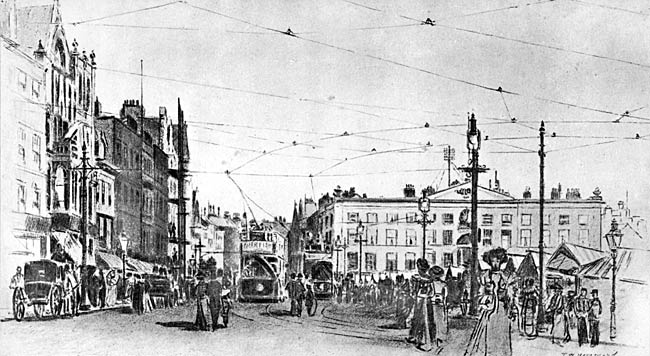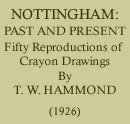< Previous | Contents | Next >
NOTTINGHAM PAST & PRESENT: STREETS AND YARDS
THE MARKET PLACE, 1910

This picture gives us some idea of what Nottingham Market Place looks like on an ordinary market day. It shows us in the distance the Exchange or the 'New Exchange' as it used to be called. In the earlier part of its life, the front of this Exchange was carried on columns forming a piazza similar to that still existing along Long Row, but in 1814 it was remodelled under Staveley and brought to its present condition.
The police offices of the town were situate on Smithy Row, in the rooms at present occupied by the Custodian of the Exchange, while Smithy Row itself reminds us of the time when Nottingham was celebrated for its iron work and the jingle 'The Little Smith of Nottingham does work that no man can' was common talk throughout England. It probably referred to Huntingdon Shaw, a very able craftsman, who died in 1780, and whose handiwork can still be studied in the magnificent gates at the entrance to Watnall Hall.
In front of the Exchange stood the whipping post and pillory which was last occupied by a criminal named Galvin, in 1808; one of the five sets of stocks in use in the town also stood here : all these were cleared away in 1826, and the Market Place was tidied up and repaved. Previous to that time there had been a deep slough, or open drain, in front of the Long Row, which was filled up with soil from Gallows Hill, and I have often wondered whether the amphitheatre in the church cemetery, generally known as the 'Devil's Punch Bowl', was the site from which the soil was taken.
A very curious fire took place somewhere on Long Row in 1788. A certain Lieutenant Bright who was resident in the town upon military business retired to rest and soon after his retirement smoke and flames were seen to be issuing from his room; an entry was made, but Lieutenant Bright was found to have succumbed. An investigation followed and the conclusion arrived at was this : Lieutenant Bright had introduced into the town the hitherto unknown custom of wearing braces, and it was surmised that when he retired to rest he became so entangled in endeavouring to take off the dangerous things that he knocked his candle over and, being unable to escape from the flames, lost his life in consequence of his devotion to braces, and so died a martyr to progress.
